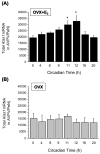The role of kisspeptin and RFamide-related peptide-3 neurones in the circadian-timed preovulatory luteinising hormone surge
- PMID: 21592236
- PMCID: PMC3384704
- DOI: 10.1111/j.1365-2826.2011.02162.x
The role of kisspeptin and RFamide-related peptide-3 neurones in the circadian-timed preovulatory luteinising hormone surge
Abstract
Many aspects of female reproduction often require intricate timing, ranging from the temporal regulation of reproductive hormone secretion to the precise timing of sexual behaviour. In particular, in rodents and other species, ovulation is triggered by a surge in pituitary luteinising hormone (LH) secretion that is governed by a complex interaction between circadian signals arising in the hypothalamus and ovarian-derived oestradiol signals acting on multiple brain circuitries. These circadian and hormonal pathways converge to stimulate a precisely-timed surge in gonadotropin-releasing hormone (GnRH) release (i.e. positive-feedback), thereby triggering the preovulatory LH surge. Reflecting its control by afferent circadian signals, the preovulatory LH surge occurs at a specific time of day, typically late afternoon in nocturnal rodents. Although the specific mechanisms mediating the hormonal and circadian regulation of GnRH/LH release have remained poorly understood, recent findings now suggest that oestradiol and circadian signals govern specific reproductive neuropeptide circuits in the hypothalamus, including the newly-identified kisspeptin and RFamide-related peptide (RFRP)-3 neuronal populations. Neurones producing kisspeptin, the protein product of the Kiss1 gene, and RFRP-3 have been shown to provide excitatory and inhibitory input to GnRH neurones, respectively, and are also influenced by sex steroid and circadian signals. In the present review, we integrate classic and recent findings to form a new working model for the neuroendocrine regulation of the circadian-timed preovulatory LH surge in rodents. This model proposes kisspeptin and RFRP-3 neuronal populations as key nodal points for integrating and transducing circadian and hormonal signals to the reproductive axis, thereby governing the precisely-timed LH surge.
© 2011 The Authors. Journal of Neuroendocrinology © 2011 Blackwell Publishing Ltd.
Figures


References
-
- Moenter SM, Brand RC, Karsch FJ. Dynamics of gonadotropin-releasing hormone (GnRH) secretion during the GnRH surge: insights into the mechanism of GnRH surge induction. Endocrinology. 1992;130(5):2978–84. - PubMed
-
- Moenter SM, Caraty A, Karsch FJ. The estradiol-induced surge of gonadotropin-releasing hormone in the ewe. Endocrinology. 1990;127(3):1375–84. - PubMed
-
- Sarkar DK, Chiappa SA, Fink G, Sherwood NM. Gonadotropin-releasing hormone surge in pro-oestrous rats. Nature. 1976;264(5585):461–3. - PubMed
-
- Freeman ME. The neuroendocrine control of the ovarian cycle of the rat. In: Knobil E, Neill JD, editors. The Physiology of Reproduction. Raven Press, Ltd; New York: 1994. pp. 613–58.
-
- Goodman RL, Inskeep EK. Neuroendocrine control of the ovarian cycle of the sheep. In: Knobil E, Neill JD, editors. The Physiology of Reproduction. Raven Press Ltd; New York: 2006. pp. 2389–447.
Publication types
MeSH terms
Substances
Grants and funding
LinkOut - more resources
Full Text Sources

